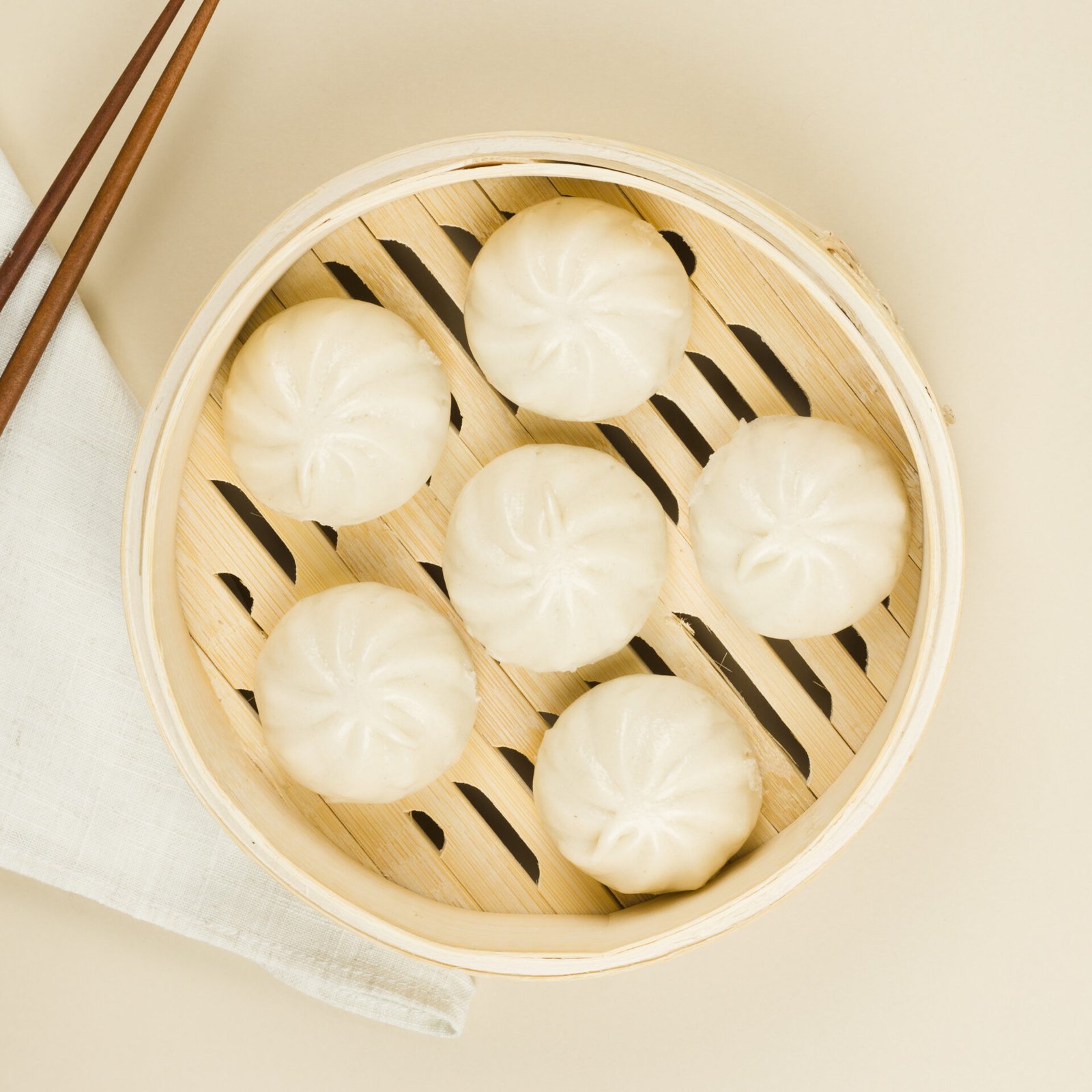Dim Sum

Making Dim Sum at home can be a fun and rewarding culinary project. Here’s a step-by-step guide to making a classic Dim Sum dish: Shumai (also spelled Siu Mai), which are open-faced dumplings typically filled with a mixture of ground pork and shrimp.
Ingredients:
For the filling:
– 250g ground pork
– 150g peeled and deveined shrimp, finely chopped
– 2-3 water chestnuts, finely chopped (optional, for crunch)
– 2-3 shiitake mushrooms, finely chopped (rehydrated if using dried mushrooms)
– 2 green onions, finely chopped
– 1 tablespoon soy sauce
– 1 tablespoon oyster sauce
– 1 tablespoon sesame oil
– 1 teaspoon sugar
– 1 teaspoon cornstarch
– Salt and pepper to taste
Other:
– Round dumpling wrappers (often available at Asian grocery stores)
– Pea shoots or lettuce leaves for lining the steamer (optional, for steaming)
Instructions:
1. Prepare the Filling:
1. In a large basin, blend the coarsely ground pork with the chopped shrimp, water chestnuts, shiitake mushrooms, and green onions.
2. Technically, you can use this recipe to add the sauce to whatever meat, vegetable or tofu dish you may be cooking; however, for simplicity, you can use the following steps: Pour soy sauce, oyster sauce and sesame oil into the bowl with sugar, cornstarch, salt, and pepper.
3. Combine the ingredients gently with spoon until the ingredients are thoroughly incorporated. It should be well flavoured with a little bit of stickiness which comes from the starch in Irish potatoes.
2. Assemble the Shumai:
1. Speaking of the implement section, start by putting a dumpling wrapper on palm of your hand or a flat surface.
2. Place approximately 1 tablespoon of the filling at the middle of the wrapper.
3. Bring the edges of the wrapper together around the filling and fasten it to enclose the contents, but leave the top exposed, and if preferred, make a pleat with the wrapper. The pastry should also be of such a way that the filling will be fully exposed at the top.
3. Steam the Shumai:
1. Place the basket in a steamer and fill with pea shoots or lettuce leaves to avoid the skins from sticking to the basket (optional).
2. If it is still hot, place the assembled shumai in the steamer basket but should not overcrowd it by leaving some gaps between the Shumai so that they do not stick together while steaming.
3. Have you ever tried boiling the water in a pot or a wok if not here is how to do it.
4. Then steam the food by placing the steamer basket on top of boiling water without letting the water splash through the basket.
5. Place the lid on the steamer and steam the Shumai for roughly 8-10 minutes or until the filling was cooked through and the skin of the Shumai pale, translucent and was tender.
4. Serve:
1. When they are ready to be served, it is also important to remove the steamer basket carefully from the heat source.
2. Using a spatula or tongs, transfer the Shumai to a plate these tools help in lifting the delicate dumplings without tearing or breaking them.
3. It is advisable to serve the Shumai hot, with preferred dips to spoon such as soy sauce, chili oil or, soy sauce mixed with rice vinegar.
That is it; let me know if you need the remainder of the ingredients list and happy preparing your homemade Dim Sum Shumai! You can also try to change the filling, its type and, therefore, make corrections in this regard to the taste preferences.
Calories in Dim Sum
Dim sum is not only a delicious culinary tradition but also has a rich history and potential health benefits. Let’s explore both sides:
Dim Sam History:
Dim sum originated in southern China, specifically Guangdong province, and Hong Kong over 2,000 years ago during the Silk Road era Originally, it was a simple meal for leisure travelers along ancient trade routes in tea houses. Over time, it developed into a culinary tradition characterized by small bite-sized dishes served on bamboo steamers or small plates During the Song Dynasty, dim sum became popular and became a Chinese culture and main part of food.
Benefits of Dim Sam:
1. Variety: Dim sum offers a variety of ingredients including vegetables, seafood, meat and rice, providing a variety of nutritional value
2. Portion Control: Dim Sum dishes are typically small in size, allowing for portion control and the opportunity to sample a variety of flavors without overeating.
3. Steam Cooking Method: Many dim sum dishes are prepared with hot water, which helps ingredients retain nutritional value and eliminates the need to add fat or oil.
4. Social and Cultural Experience: Enjoying dim sum with family and friends in the community enhances social bonds and strengthens relationships, contributing to overall well-being.
5. Tea pairing: Dim sum is traditionally served with tea, not only enhancing the dining experience, but also providing potential health benefits such as antioxidants and water a it also causes bleeding.
6. Balanced dishes: Dim sum dishes tend to have a balance of sweet, sour, sour and spicy, making for a satisfying and enjoyable dining experience
7. Dim sum health: Many dim sum dishes contain fibrous ingredients such as vegetables and whole grains, which can support digestive health and regularity.
8. Cultural Appreciation: Exploring dim sum allows individuals to appreciate and celebrate Chinese culture and culinary traditions, promoting cultural diversity and understanding.
While dim sum can be a delicious and enjoyable culinary experience, it is important to pay close attention to serving size and ingredients, especially for individuals without dietary restrictions or health concerns. Having dim sum in moderation as part of a balanced diet can help lead a healthy and fulfilling life.
Also read: Chilli Garlic Sauce
